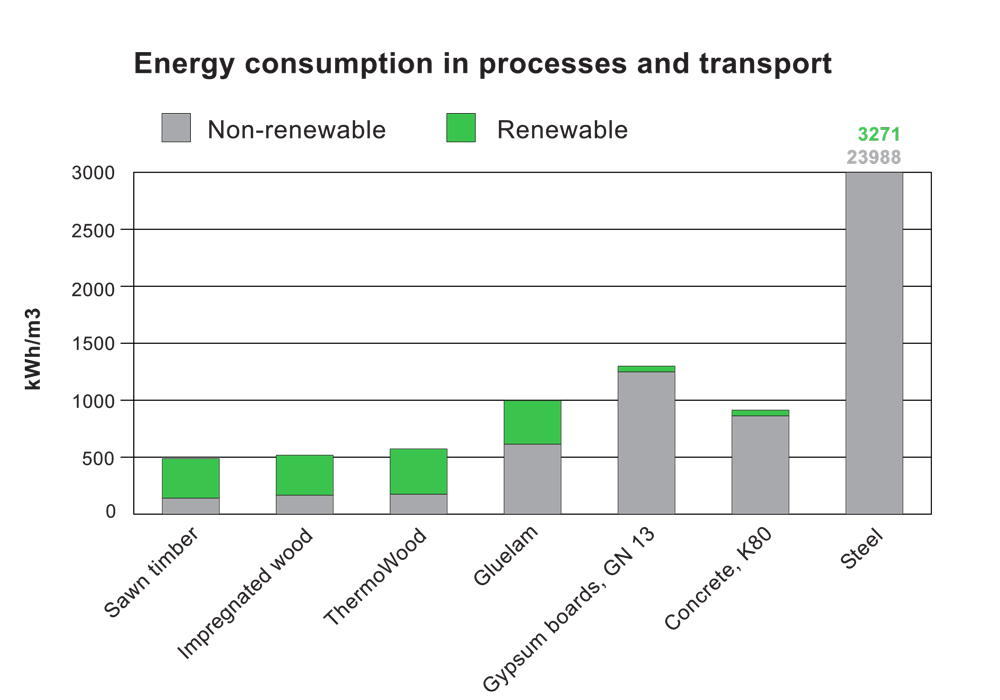ThermoWood® - ENVIRONMENTAL ASPECTS
Certified raw material
The FFCS ( Finnish Forest Certification System) was developed for Finnish circumstances and it demonstrates reliably how the Finnish certified forests are managed and used. The certification system includes all the essential components for forest certification: requirements for forest management and use and chain of custody verification as well as the qualification criteria for external auditing. The FFCS was accepted by PEFC (Programme for the Endorsement of Forest Certification schemes) forest certification system. The Finnish Forest Certification Council issues the PEFC logo use rights in Finland on the behalf of the PEFC Council. About 90% of sawn wood that is thermally modified in Finland comes from PEFC certified forests.
Information about FFCS and PEFC forest certification systems can be found at www.ffcs-finland.org and www.pefc.org
Finnish ThermoWood Association has members also in other countries where other forest certification systems are used.
Energy
During production process of ThermoWood energy is needed mainly for drying, which accounts for 80 % heat energy used. The total energy consumption is approximately 20 % higher than that of ordinary sawn timber drying process to 18 % moisture content. Compared to lower moisture content the energy consumption is close to equal due to shorter process time. In most cases the energy is produced by burning bark and wood waste.
The picture below represents energy consumption of some building material for processes and transportation. The origin of energy is divided to renewable (bio-energy, wind-, solar- and water- power) and non-renewable (fossil fuel) sources.

Source: www.rts.fi/ymparistoseloste/voimassaolevatympselos...
(sawn timber, gluelam, gypsum board, concrete, steel) Industry (ThermoWood, impregnated wood)
Emissions
The emissions of ThermoWood in the surrounding air are very low. Attached table includes the results of measurements of total volatile organic compounds (TVOC) from thermally modified pine and spruce. The age of measured products was four weeks.
| PRODUCT | TVOC mg/(m2h) , 28 d | TVOC mg/m3, 28 d |
| Thermo-S, pine | 0,090 | 0,255 |
| Thermo-S, spruce | 0,084 | 0,237 |
| Source: Research reports VTT-S-00986-06 and RTE3218_6/05. |
Because the manufacturing process of ThermoWood is based only on the use of high temperature and steam, any harmful substances do not leach to the ground from products.
Maintenance cycle
Thermal modification improves stability of wood. Because of reduced deformation (swelling, shrinkage, warp) ThermoWood is good base for coating. Resin is removed during thermal modification and does not penetrate through coating layer of applications. Coated surface of ThermoWood keeps longer in good condition. Lengthened maintenance cycle reduces consumption of substances that are needed for manufacturing of coatings.
Service life
Thermal modification increases durability of wood and lengthen its service life in many end uses. Long service life reduces need of transportation and need of products that are environmentally doubtful.
Replacement
The visual appearance of ThermoWood is similar to tropical hardwoods. In some end uses ThermoWood can be used instead of non-sustainable wood species. Compensatory use reduces transportation and save endangered forests.
Disposal
In the end of its service life ThermoWood can be exploited in energy production or placed into the normal waste system like normal wood.





